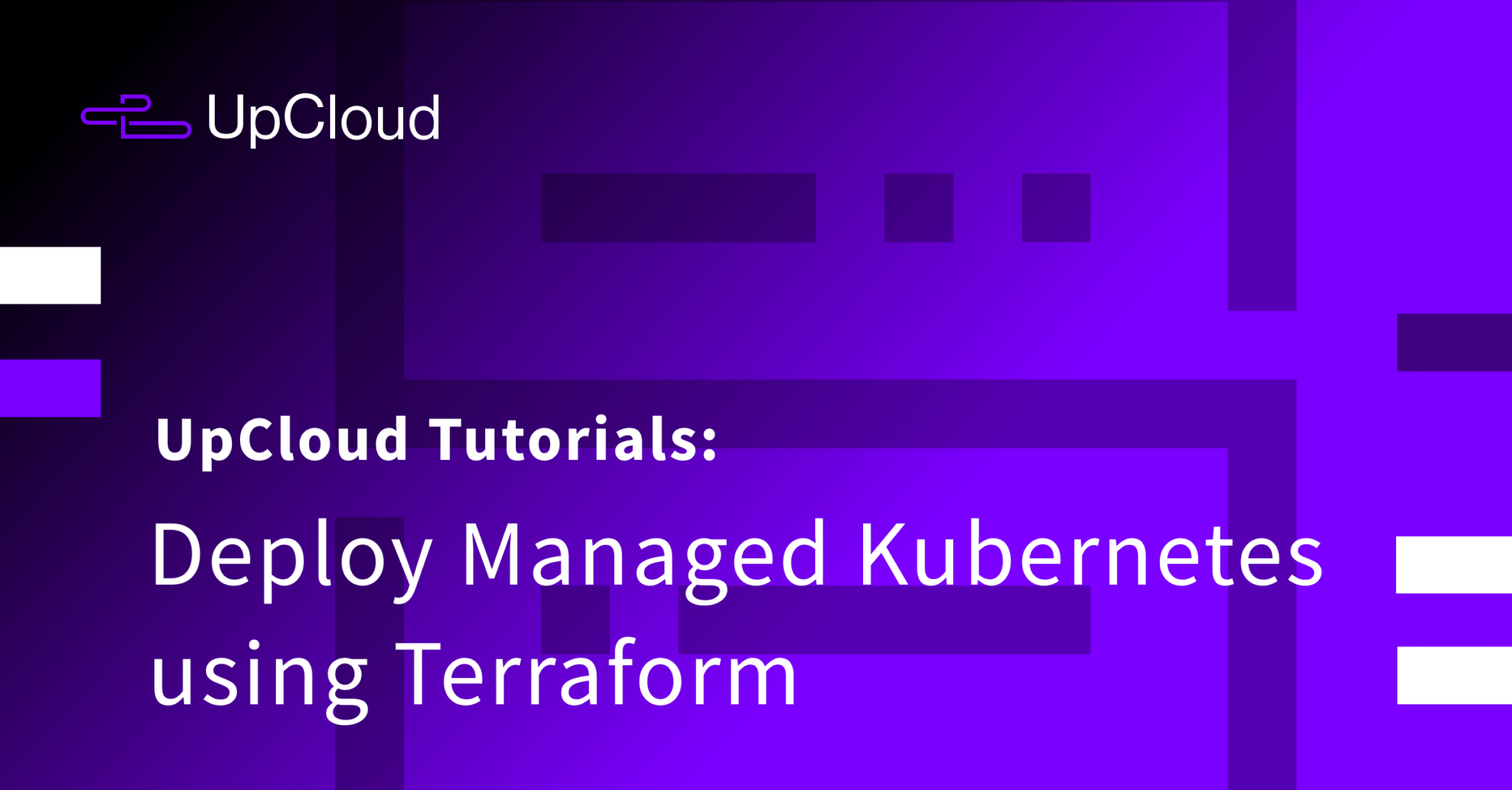Managed Kubernetes easily automates the deployment, scaling, and management of container workloads but takes a couple of steps to deploy by itself. So, what better solution to combine with Managed Kubernetes than the simple yet powerful open-source infrastructure management tool, Terraform.
In this tutorial, we’ll show to set up a Terraform configuration for a Managed Kubernetes cluster and how to get it up and running.
Installing Terraform
First things first. If you haven’t used Terraform before, you will need to start by installing it. You can follow our beginners’ tutorial to accomplish this and then come back and continue here.
You can also check out the official UpCloud Terraform provider documentation if you want to learn more.
Setting up Managed Kubernetes
Once you have Terraform installed and ready, start by creating a new directory on your own computer to house your Terraform configuration files. The actual location of this folder doesn’t matter as such as the only requirement is that only one Terraform configuration is saved in any specific directory.
Terraform configuration structure
Next, you’ll need a starting point. Rather than having you copy and paste from our tutorial, we’ve made public Managed Kubernetes example files available in our GitHub repository.
The main repo contains a whole host of information about example integrations with Managed Kubernetes but we’ll focus here on the cluster creation. You can download the Terraform cluster example configuration folder individually using the handy download-directory.github.io web tool and ignore the rest for now.
The cluster configuration is organized into the following files:
- main.tf
This defines the managed resources: upcloud_kubernetes_cluster, upcloud_network - provider.tf
Includes the main terraform block and provider-specific configurations - variables.tf
These define the input variables used in the configuration, e.g. zone - outputs.tf
Output values provide information about our deployment when it’s ready, like the cluster ID
There are default values for provider.tf that allow the provider to authenticate against the Kubernetes cluster defined in this configuration. The credentials acquired by upcloud_kubernetes_cluster and defined in data.tf file.
Feel free to make modifications to the files as necessary. The official documentation covers additional information needed on how to use the provider and its resources.
Provisioning
When you have the configuration files all set, you can begin by initializing the directory.
terraform init
Terraform will then download the required plugins. You should see an output similar to below.
Initializing the backend... Initializing provider plugins... - Finding latest version of hashicorp/local... - Finding latest version of hashicorp/kubernetes... - Finding upcloudltd/upcloud versions matching ">= 2.11.0"... - Installing hashicorp/local v2.4.0... - Installed hashicorp/local v2.4.0 (signed by HashiCorp) - Installing hashicorp/kubernetes v2.22.0... - Installed hashicorp/kubernetes v2.22.0 (signed by HashiCorp) - Installing upcloudltd/upcloud v2.12.0... - Installed upcloudltd/upcloud v2.12.0 (self-signed, key ID 60B4E1988F222907) Partner and community providers are signed by their developers. If you'd like to know more about provider signing, you can read about it here: https://www.terraform.io/docs/cli/plugins/signing.html Terraform has created a lock file .terraform.lock.hcl to record the provider selections it made above. Include this file in your version control repository so that Terraform can guarantee to make the same selections by default when you run "terraform init" in the future. Terraform has been successfully initialized! You may now begin working with Terraform. Try running "terraform plan" to see any changes that are required for your infrastructure. All Terraform commands should now work. If you ever set or change modules or backend configuration for Terraform, rerun this command to reinitialize your working directory. If you forget, other commands will detect it and remind you to do so if necessary.
Next, test that the configuration is ready to deploy by running the terraform plan command.
terraform plan
Terraform used the selected providers to generate the following execution plan. Resource actions are indicated with the following symbols: + create <- read (data resources) Terraform will perform the following actions: # data.upcloud_kubernetes_cluster.example will be read during apply # (config refers to values not yet known) ... Plan: 4 to add, 0 to change, 0 to destroy. Changes to Outputs: + cluster_id = (known after apply)
The above example output has been truncated for brevity.
Lastly, if the plan looks all correct and Terraform didn’t report any issues, go ahead and deploy the setup. Confirm the deployment by answering yes when prompted.
terraform apply
You will then see a confirmation of the configuration followed by the deployment process. Running apply will create a network, a cluster, and a Kubernetes namespace in the new cluster.
... Plan: 4 to add, 0 to change, 0 to destroy. Changes to Outputs: + cluster_id = (known after apply) upcloud_network.example: Creating... upcloud_network.example: Creation complete after 2s [id=03e416f9-0812-48bb-b58b-cf4ac74161eb] upcloud_kubernetes_cluster.example: Creating... upcloud_kubernetes_cluster.example: Still creating... [10s elapsed] ... upcloud_kubernetes_cluster.example: Creation complete after 6m57s [id=0d1f7c52-4910-4970-b150-a07dce8615e2] data.upcloud_kubernetes_cluster.example: Reading... upcloud_kubernetes_node_group.group: Creating... data.upcloud_kubernetes_cluster.example: Read complete after 0s [id=0d1f7c52-4910-4970-b150-a07dce8615e2] local_file.kubeconfig[0]: Creating... local_file.kubeconfig[0]: Creation complete after 0s [id=68796076a5b3afcce490db2a9464019b94a662ad] upcloud_kubernetes_node_group.group: Creation complete after 1s [id=0d1f7c52-4910-4970-b150-a07dce8615e2/medium] Apply complete! Resources: 4 added, 0 changed, 0 destroyed. Outputs: cluster_id = "0d1f7c52-4910-4970-b150-a07dce8615e2"
That’s it! You should now have a fully functional Managed Kubernetes cluster running on your UpCloud account just waiting for a workload to run.
